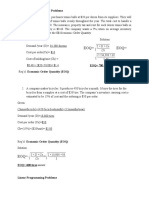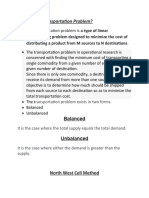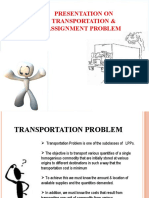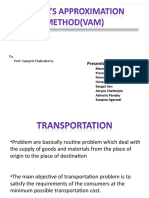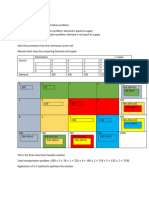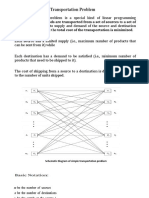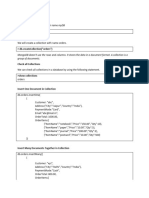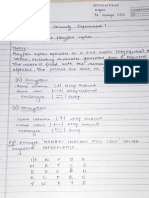0 ratings0% found this document useful (0 votes) 20 views6 pagesVAM Example Upload
Vogel approximation method
Copyright
© © All Rights Reserved
We take content rights seriously. If you suspect this is your content,
claim it here.
Available Formats
Download as PDF or read online on Scribd
Module 4: Transportation Problem
d Assignment problem
©) Transportation Problem: (Vogel’s Approximation Method)
The North-West Corner method and the Least Cost Cell method has been discussed in the
ion. In this session, the Vogel’s Approximation method will be discussed
D3 »4 Supply
300
7] 4
= 400
5| 9
osf|_ 8] 3] al 2
Solution:
* For each row find the least value and then the second least'value and take the absolute difference
of these two least values and write it in the corresponding Yow difference as shown in the image
below. In row OI, 1 is the least value and’3 is the secbnd least value and their absolute
difference is 2. Similarly, for row 02 and/O3, the absélute differences are 3 and 1 respectively.
+ For each column find the least value and thempthe second least value and take the absolute
difference of these two least values then write it in the corresponding column difference as
shown in the figure. In column D1, 2 isthe least value and 3 is the second least value and their
absolute difference is, Similatly, for column D2, D3and D3, the absolute differences
are 2, 2 and 2 respectively.
p12 ps a__—«SUP PY Row Difference
Column
Difference:
Prasad A Y, Dept of CSE, ACSCE, B'lore-74 Page 8�Module 4: Transportation Problem and Assignment problem
+ These value of row difference and column difference are also called as penalty. Now select the
maximum penalty. The maximum penalty is 3 i.e. row 02. Now find the cell with the least cost
in row O2 and allocate the minimum among the supply of the respective row and the demand of
the respective column. Demand is smaller than the supply so allocate the column’s demand
i.e, 250 to the cell. Then cancel the column D1.
Row Difference
Dema
Column
Difference;
+ From the remaining cells, find out the row difference 4nd column difference.
Column
Differencs
+ Again select the maximum penalty which is 3 corresponding to row O1. The least-cost cell in
row O1 is (01, D2) with cost 1, Allocate the minimum among supply and demand from the
Prasad A Y, Dept of CSE, ACSCE, B'lore-74 Page 9�Module
‘ransportation Problem and Assignment problem
respective row and column to the cell. Cancel the row or column with zero value.
Row Difference
Demand:
Column
Difference;,
‘* Now find the row difference and column di
Destinatior
rence from the remaining cells.
DI op2 «D3 pa Supply Row Difference
Column
Differenc
+ Now select the maximum penalty which is 7 corresponding to column D4. The least cost cell in
column D4 is (03, D4) with cost 2, The demand is smaller than the supply for cell (03, D4).
Allocate 200 to the cell and cancel the column,
Prasad A Y, Dept of CSE, ACSCE, B'lore-74 Page 10�Module
‘ransportation Problem and Assignment problem
supply Row Difference
Column
Differenos
+ Find the row difference and the column differénee from th€ remaining cells.
Destin:
Row Difference
Column
Difference
+ NoWpthe maximum penalty is 3 corresponding to the column D2. The cell with the least value
in D2 is (03, D2). Allocate the minimum of supply and demand and cancel the column.
Prasad A Y, Dept of CSE, ACSCE, B'lore-74 Page 11�jodule 4: Transportation Problem
d Assignment problem
Supply Row Difference
source
Demand:
Column
Difference:
+ Now there is only one column so select thé cell with the least cost and allocate the value.
Column
Difference,
Prasad A Y, Dept of CSE, ACSC! Page 12,�Module
‘ransportation Problem and Assignment problem
+ Now there is only one cell so allocate the remaining demand or supply to the cell
Destination
blob? pa Supply Row Difference
Source
Demand:
Column
Differences
+ No balance remains, So multiply the allocated value of the céllS with their corresponding cell
cost and add all to get the final cost i.e. (300 * 1) + (250 *\2) + (50 * 3) + (250 * 3) + (200 * 2)
+ (150 * 5) = 2850
Prasad A Y, Dept of CSE, ACSCE, B'lore-74
Page 13,

















